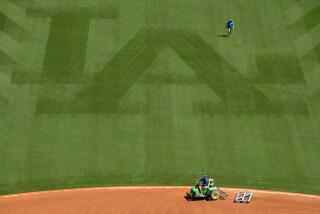Knock on Wood
- Share via
It was in a recent game against the Washington Nationals that Angel first baseman Darin Erstad was confronted by what has become a familiar problem: He could field the distracting and dangerous barrel half of a broken bat spiraling toward him or the ground ball headed for the hole on the right side of the infield.
Erstad hasn’t won three Gold Gloves by stacking lumber, so he ducked the bat, fielded the grounder and got the out at first. He later shrugged off the threat posed by the latest flying missile as line-of-duty stuff in a season in which so many bats are breaking that “Splendid Splinter” has taken on new meaning.
“An epidemic,” said Angel bench coach Joe Maddon, or as coaching colleague Mickey Hatcher put it:
“It’s unbelievable. We’re seeing eight to 10 bats break every game. Guys are coming back saying they hit the ball on the sweet spot and it still broke. I don’t know if the bats are just too dry or they put the label on the wrong side, but there’s an awful lot of firewood being left on the infield every night.”
So much firewood that Angel pitcher Jarrod Washburn, dodging it from 60 feet 6 inches, is thinking of asking for hazard pay in his next contract, especially after he shuddered and saw the spiked end of a broken bat stick in the mound during a recent game.
“They’re breaking like crazy,” Washburn said. “I’m surprised someone hasn’t been hurt yet, but it will happen.”
What’s happening?
Have termites hit the bat market?
Are more bats breaking, or is it a black-lacquered illusion?
Mindful of baseball’s steroid infestation, Sam Holman has a one-word summary for the evolving bat scene.
“Mapleroid,” said the Sam of SamBat, the Ottawa company that in a short span has become the third-leading supplier of bats to major league players.
All of SamBat’s bats are maple.
In a market dominated for more than a century by the white ash of the Hillerich & Bradsby Co.’s Louisville Slugger, still the leading manufacturer of big league bats, maple has cut into the ash stranglehold to the extent that even Hillerich’s orders are almost 50-50.
When Barry Bonds hit 73 home runs using a SamBat maple in 2001, there was a stampede by fickle players always looking for an edge.
Of course, Bonds is Bonds.
“It doesn’t matter what kind of bat Barry swings,” Maddon said. “He’s always going to hit the heart of the artichoke. The rest of them get leaves.”
True, perhaps, but hitters take a paternalistic approach to their bats, or as Rex Hudler, the Angel analyst who spent 13 years in the big leagues, explained: “I would always put my bats next to those of the team’s hottest hitter hoping something would rub off.”
“When I was with the Yankees,” Hudler said, “Don Mattingly would even take his bats to bed. If his wife complained, he’d tell her, ‘Honey, I keep my bats warm at night so that you’ll have money to go shopping during the day.’ ”
Stories are bountiful.
Former Angel shortstop Leo Cardenas was so superstitious that he would put his bats in the trunk of his car and drive through a cemetery at night to ward off the evil spirits of a slump. Ken Griffey Jr. orders a double dipping of lacquer to harden the barrel.
A small number of players were using the harder and more durable maple before Bonds, but those 73 homers -- perhaps chemically aided or not -- triggered a revolution that has contributed to the shattering image of 2005.
No one keeps tab -- official or otherwise -- on the number of broken bats.
Ken Higdon, the Angel equipment manager, said his budget of the last few years hasn’t significantly changed. All clubs pay for bats. Higdon said he continues to order about eight dozen per player per season. He doesn’t think there’s been a significant increase in broken bats.
If the nightly camera suggests otherwise, as skittish infielders duck, dodge and take cover, the widespread and generally unanimous view is that maple simply breaks in a different and more visible way than ash. Thus, because of the significant increase in the number of players using maple bats, it appears that more bats are breaking.
“Maple tends to break in two, and what you see is half of the bat flying across the infield,” said Chuck Schupp, Hillerich & Bradsby’s director of professional sales. “Ash tends to splinter or flake. It’s not always visible from the stands, and a hitter may not realize it’s cracked until he gets back to the dugout and looks at it.”
Whether maple or ash, two significant factors have contributed to the broken-bat siege.
* Bigger, stronger hitters conditioned to swinging light aluminum bats in high school and college are demanding similarly light wood bats with thin handles and big barrels -- “they often have micro-specific requests that are difficult to produce,” Schupp said -- and the combination of bigger hitters/lighter bats is a physics challenge. The 39- to 42-ounce R-43 model Louisville Slugger employed by Babe Ruth? Now, a 32- to 34-ounce bat is about average and maybe slightly heavy.
* Hitters and their thin-handled bats are increasingly getting sawed off by sliders and cut fastballs delivered by pitchers with deep repertoires who are not limited to throwing straight fastballs when behind in the count. The cut fastball of New York Yankee closer Mariano Rivera alone has accounted for enough firewood to heat a Bronx winter.
In addition, the rush to fill maple orders has possibly produced a wide variance in quality control and drying procedures. There are more than 220 bat patents and about 30 companies whose bats have been tested by Major League Baseball and approved to sell to clubs and players.
The companies must pay a fee to MLB and show product liability insurance.
“Anybody with a lathe in their garage thinks he can make a bat,” said Holman of SamBat, “but in our case we don’t consider ourselves bat makers. We think of ourselves as instrument makers. I’m not sure the quality control in other companies is as high as ours.”
A woodworker and stagehand at Ottawa’s National Arts Center for 23 years, Holman has taken SamBat from an experimental start in 1996 to a point where it is producing 17,000 bats a year, 7,000 of which go to major leaguers. Only Hillerich & Bradsby, at No. 1, and Rawlings Sporting Goods, which now operates Adirondack, sell more to MLB. A maple Louisville Slugger costs $58 at the MLB scale while ash goes for $45.
Roy Krasick, baseball’s senior director of major league operations, said his tests have indicated there is no difference in the way the ball comes off either bat. Bonds and his maple sycophants might dispute that, but the MLB jury is about split based on sales.
“Players are always tweaking what they use, switching from one model to another, from one wood to another, depending on how they’re doing,” said Hillerich’s Schupp, “and they’re always keeping an eye on what Bonds is using now or A-Rod or [Albert] Pujols, any of the big hitters. They leave messages for me at all hours wanting to talk bats.”
Among the Angels, for instance, Erstad said he admires the off-season and batting-practice durability of maple but prefers the flex and feel of ash in his game bat. Steve Finley, a maple pioneer since 1996, has now switched back to ash, complaining that he hasn’t been getting consistent weight with his maple bats and too many, in the last few years, have been shattering “even when I hit it on the head.”
“Maybe there are internal cracks that don’t show on the exterior,” Finley said of his maple problems. “With ash, you know what you’re getting.”
Finley, of course, had been struggling before going on the disabled list last week, so it’s no surprise he would have been experimenting.
Hitters universally tend to believe their problems may be with the bat and not the person swinging it. In the future, as bat companies work on a hybrid beech combining elements of ash and maple, the hitters may not have to worry about which wood to use.
As for breakage, that’s always likely to be a knotty problem with no definitive explanation.
*
(BEGIN TEXT OF INFOBOX)
Ash versus maple
Ash and maple bats were nearly identical in ball-striking characteristics, according to a committee commissioned by Major League Baseball and led by James Sherwood, a University of Massachusetts Lowell engineer. Comparing the two woods:
* Similar-size maple bats are heavier than ash bats.
* About 52% of major leaguers use ash bats; 48% use maple.
* Ash bats cost about $45 apiece; maple bats cost about $58.
* Ash tends to splinter; maple tends to snap more cleanly.
* Ash bats can flex, and there can be a trampoline effect when the ball is hit. Maple bats are more dense and flex significantly less. The surface is about 20% harder than ash.
*
Note: A few major league players this season are using bats made of “European” beech. Like maple, beech is very dense.
*
Source: SamBats; Hillerich & Bradsby; ViperBats.com
Los Angeles Times
More to Read
Go beyond the scoreboard
Get the latest on L.A.'s teams in the daily Sports Report newsletter.
You may occasionally receive promotional content from the Los Angeles Times.






